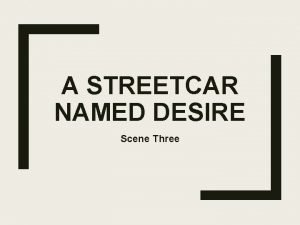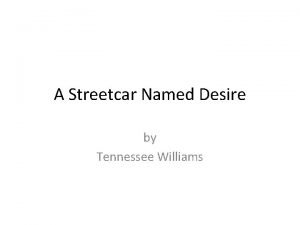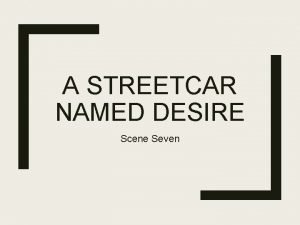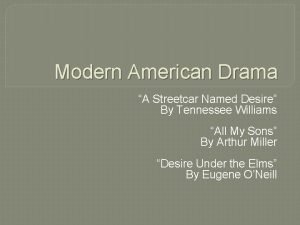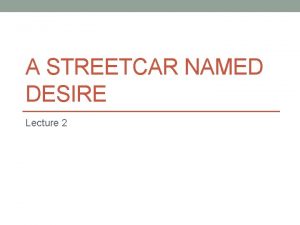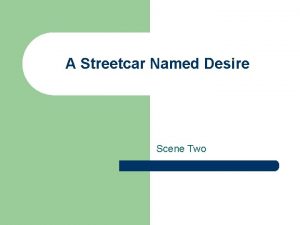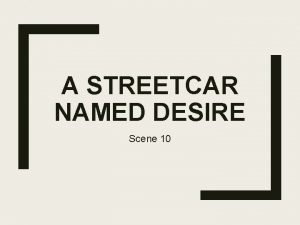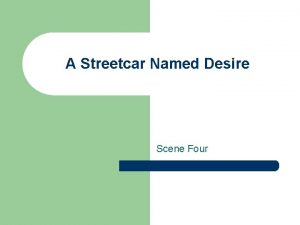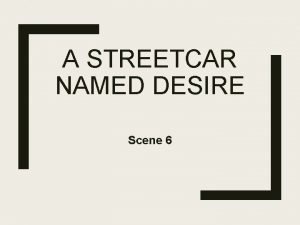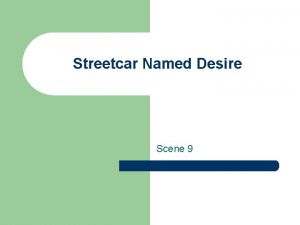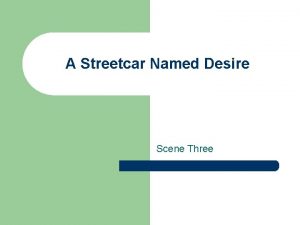Streetcar Named Desire Scene 10 Scene Ten l










- Slides: 10

Streetcar Named Desire Scene 10

Scene Ten l l This scene is the dramatic climax of the play Throughout this scene Williams uses every means available to create an atmosphere of menace: – – opening stage directions – Blanche’s “soiled and crumpled” evening dress and her “scuffed silver slippers” When she breaks the mirror we are reminded that this brings bad luck

Scene Ten – – – Stagecraft – when Stanley turns on Blanche her terror takes on a visible form as “grotesque and menacing” shapes close in around her the ugly, violent scenes within the apartment are mirrored by the ugly, violent scenes on the street outside the effect of the “inhuman voices likes cries in a jungle” and sinuous shadows on the walls around Blanche are to create a shocking visual and sound impact in keeping with the horror of a man raping his sister-in-law while his wife is giving birth to their child

The Rape l Williams mimics classical tragedy by not showing the rape. Why? – – – the omission of the rape heightens our sense of its effectiveness its omission also reflects the notions of acceptable stage behaviour held by Americans in 1947 the sense of the inevitability of the rape is another reason why it seems unnecessary that it takes place on-stage

The Rape l l The way Stanley terrorises Blanche by shattering her selfdelusions parallels and foreshadows his physical rape of her The impending rape is symbolised through Stanley’s macho animalistic body language – “snake”, “springs towards her”. He is described as more animal-like than human Stage directions – the jungle noises symbolise the primitive nature of Stanley and danger for Blanche His rape of Blanche when he is at his most triumphant ( just before the birth of his son) and she is at her most psychologically vulnerable symbolises the ultimate act of cruelty

The Rape l l The rape symbolises the final destruction of the Old South’s genteel fantasy world symbolised by Blanche, by the cruel but vibrant present symbolised by Stanley The rape further symbolises that in the new world of the South, animal instinct and common sense win out over lofty ideals and romantic notions

The Rape l l Blanche’s silent resignation as Stanley carries her to the bed indicates the utter defeat of her will If the rape symbolises realism, then surely this means that Blanche’s world of dreams and fantasies is a better alternative

Stagecraft l l l The transparent setting illustrates that home is not a safe option for Blanche. There is danger on the street and in the apartment The use of the “lurid reflections” on the wall convey the nightmare world that Blanche now finds herself in The use of the blue piano music symbolises sadness and loss. All Blanche’s dreams have now been destroyed

Stagecraft l Immediately before the rape the noise of the approaching locomotive signifies the idea of fate for Blanche

Changing perception of character l l Our opinion of Stanley has changed greatly from the very beginning of the play At the start of the play he is more likeable and down to earth than Blanche. He lacks her pretension and he represents the new America where reward is based on merit and good work and not dependent on being born into fortunate circumstances
 Blue piano streetcar
Blue piano streetcar Scene ten
Scene ten Lurid reflections streetcar named desire
Lurid reflections streetcar named desire Scene three a streetcar named desire
Scene three a streetcar named desire A streetcar named desire scene 2 worksheet answers
A streetcar named desire scene 2 worksheet answers A streetcar named desire scene 7
A streetcar named desire scene 7 Plastic theatre a streetcar named desire
Plastic theatre a streetcar named desire Expressionism in a streetcar named desire
Expressionism in a streetcar named desire Plastic theatre in a streetcar named desire
Plastic theatre in a streetcar named desire Gaudy seed bearer
Gaudy seed bearer Streetcar named desire theme
Streetcar named desire theme



